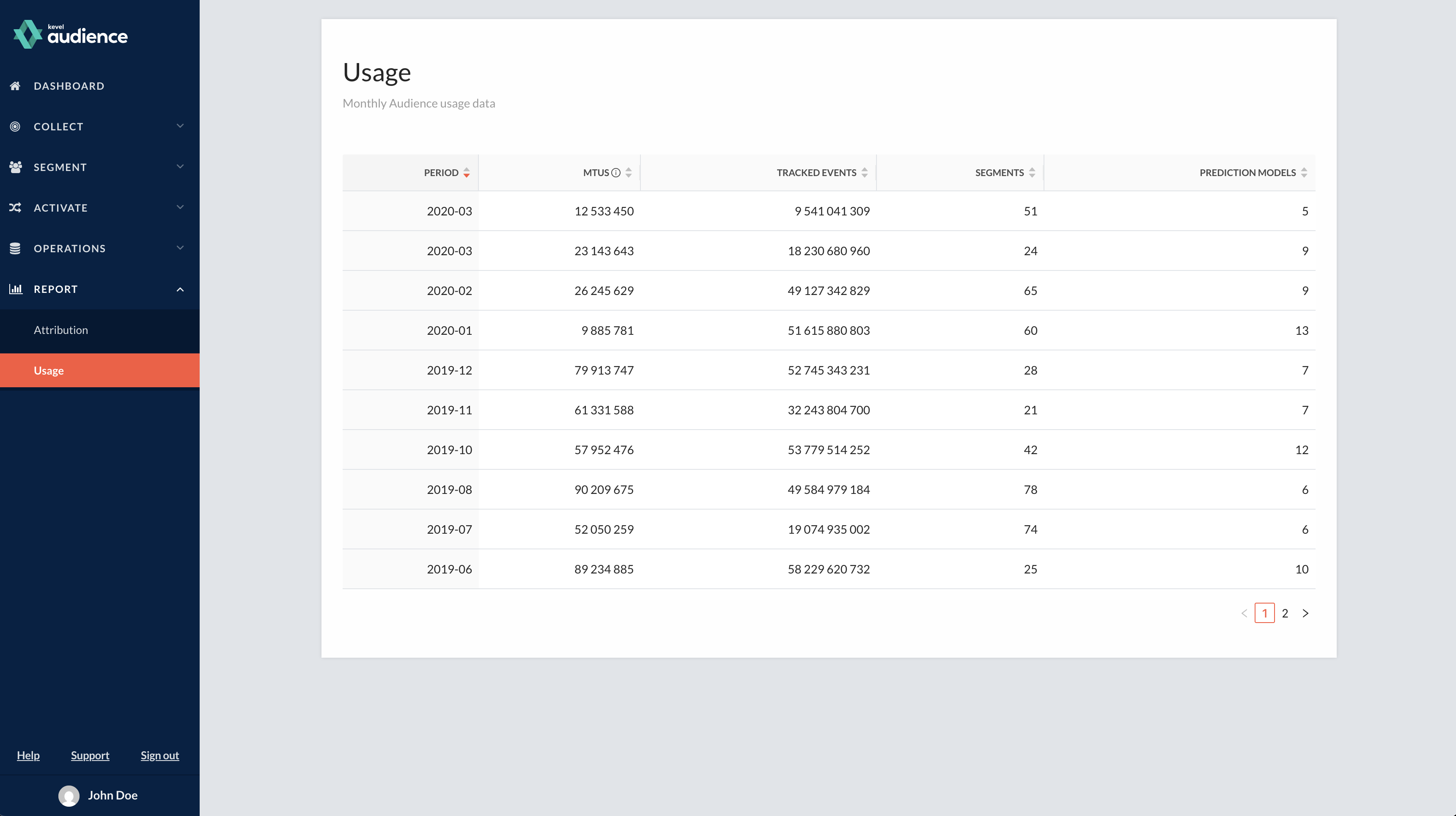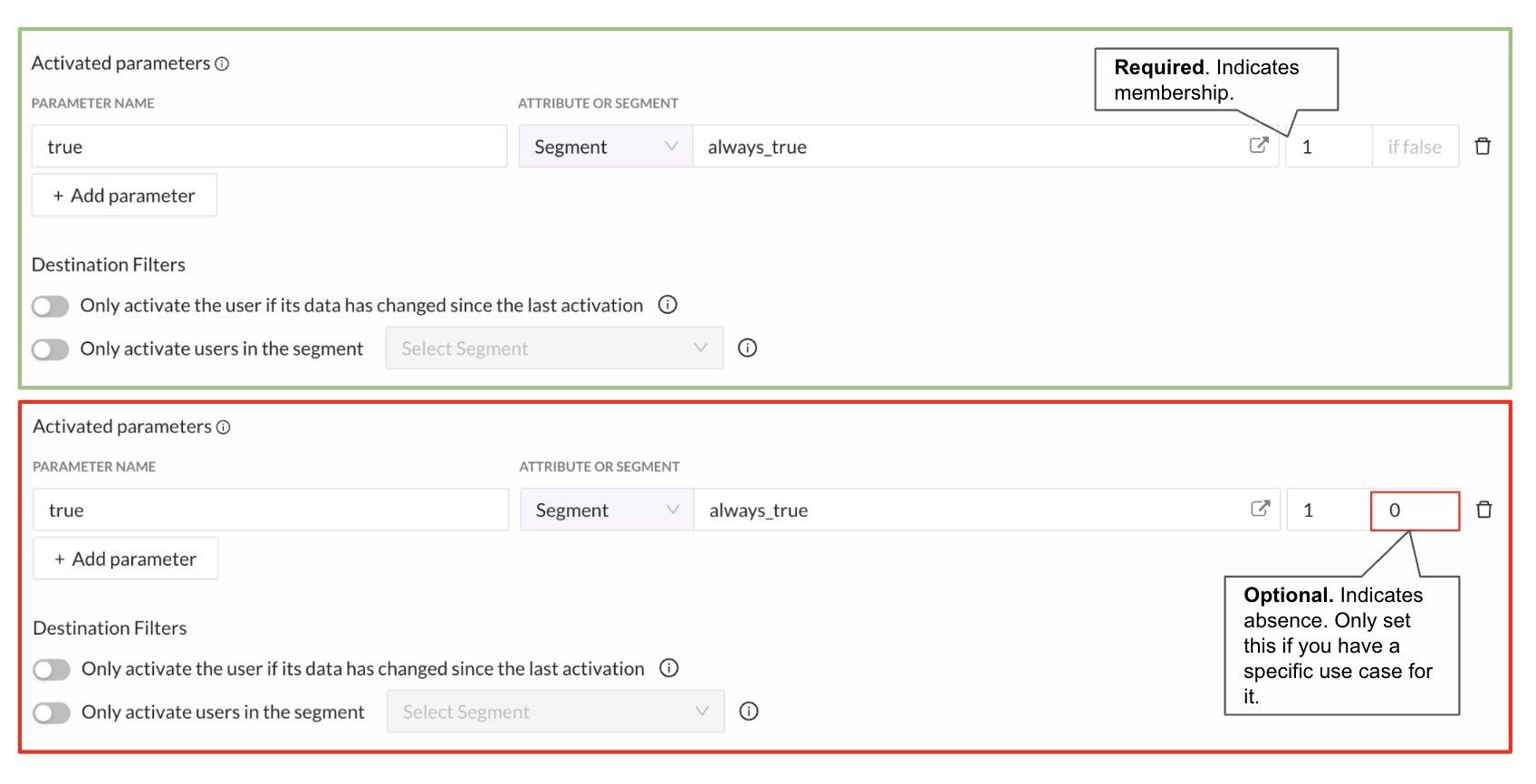Usage Report
Visualization of the System's Monthly Usage Metrics
The purpose of the Kevel Audience usage reports is to provide insights into the system's key usage metrics, enabling their aggregated visualization on a monthly cadence:
- MTUs (Monthly Tracked Users): The number of Unique Users that generate one or more events within the calendar month;
- Tracked Events: The number of tracked events within the calendar month;
- Prediction Models: The highest number of prediction models configured in the system at any time within the calendar month.
- Segments: The highest count of enabled segments recorded at any moment in the calendar month.

Calculating Monthly Tracked Users
Users are considered for the Monthly Tracked Users count in a given calendar month if they are included in any of the following activities during that month:
- Tracking requests, in which a user is required to go to the website or app, or have been involved in an Offline order import;
- Activation, Match, and Cookie Sync events.
Understanding Monthly Tracked Users
The number of Monthly Tracked Users (MTUs) in a given month can vary due to multiple factors. These are often context-dependent and may interact in ways that amplify or reduce the impact on total MTUs. Understanding what drives MTU growth can help clients optimize audience activations while staying efficient. Below, we outline the main behaviors that can increase MTUs, followed by options that can help reduce them and what does not have an impact.
Factors That Might Increase MTUs
1. Increased tracking coverage
Expanding tracking to include more website pages or importing additional offline orders increases the likelihood of capturing more unique users — which can raise MTUs.
While limiting tracking (e.g., only sending orderPlace events) may reduce MTUs, it also restricts visibility into user behavior. This can limit the customer's ability to build rich segments — such as users who added chocolate to their basket in the last 7 days — and may reduce the overall effectiveness of activation strategies.
2. Adding new destinations. The first time a new destination is configured in a client's system, Kevel Audience may activate a broader set of users.
3. Sending both users who belong and don’t belong to a segment. When adding a segment to a Destination, users must configure Activated Parameters. Setting a membership marker (i.e., users who are in the segment) is required. However, if an absence marker (i.e., users not in the segment) is also defined, this can lead to activating the entire user base, both those who belong to the segment and those who don’t.

4. Using scheduled triggers without destination filters. Without destination filters, scheduled triggers can activate the same users repeatedly, increasing MTUs unnecessarily.

5. Not sending match requests / not importing user identifiers. This prevents user consolidation and can inflate the number of distinct profiles. Note that each MTU corresponds to a user profile, and that each profile can have multiple identifiers (email, phone number, cookie, etc.). Keeping identifiers well-merged helps avoid duplicate profiles—and excess MTUs.
6. Very large segments (high reach). Broad segments can trigger activation for a wide user base, increasing MTUs.
7. Adding many non-overlapping segments to a destination. Regularly adding non-overlapping segments, even those composed of inactive users (e.g., haven’t visited the site or made an offline purchase recently), can continue to activate new users each month, increasing MTUs.
8. Activating multiple ID types. Selecting multiple ID types (e.g., email, phone number, cookie) in a destination configuration increases the chances of activation. Users only need to match on one eligible ID type to be pushed, so enabling more ID types raises overall match rates and supports higher monthly active user (MTU) counts.
Factors That Might Decrease MTUs
1. Reactive or User Profile Update triggers. Unlike scheduled triggers, reactive and user profile triggers activate users only when relevant changes occur - instead of all users in a scheduled cadence (i.e., daily).
2. Destination filters. Customers might use segment filters, for example "Filter to only send “consented users”, or check options like "Only activate users if their data has changed since the last activation". More detail can be found in the Destination Filters documentation.
Factors That Don't Impact MTUs
1. New event-based user attributes. Even though new User Attributes apply to historical events, they won’t trigger activations and will not affect MTUs.
2. The importing of User Data.
Importing User Data alone does not increase MTUs. However, it can lead to extra MTUs if the import causes a profile update that triggers activation. For example, if a user’s lifestyle attribute changes from "Fashionista" to "Sustainable parent", and the destination is configured to activate based on user profile change, this update will trigger an activation.
For example, consider this scenario, where a segment of Buyers with Purchases in the Last 30 Days is activated. Once a user falls outside that 30-day window and doesn’t return to the site nor repeats a purchase, it means:
- They don't count towards MTUs via the "tracking" vector described above.
- They can only count through "activations".
- To activate them, a destination must be associated with a server-side activation trigger, either a scheduled activation or based on a user profile update.
Prefering the first one might lead to increased MTUs, but the data shared with the destination is most accurate, as Kevel Audience both adds and removes users from segments. The second one, while potentially decreasing MTUs, might lead to less accurate targeting, since only users who enter a segment are sent; users who leave the segment are not removed from the destination.
These effects tend to be more noticeable in newer Audience setups, where:
- few segments or attributes are currently activated, so each new one has a larger impact.
- few destinations are configured, so adding a new one triggers more noticeable user activation.
When Are These Reports Generated?
Kevel Audience usage reports are generated automatically at the end of each calendar month.